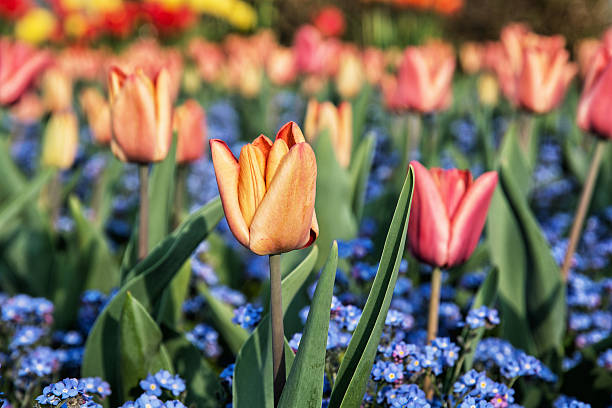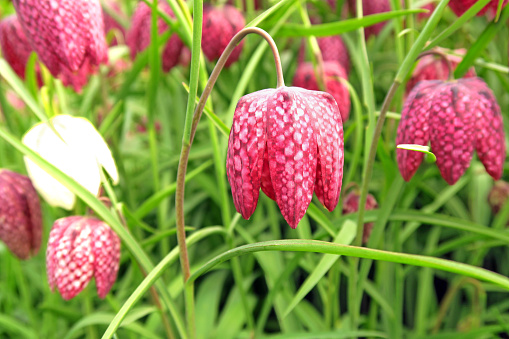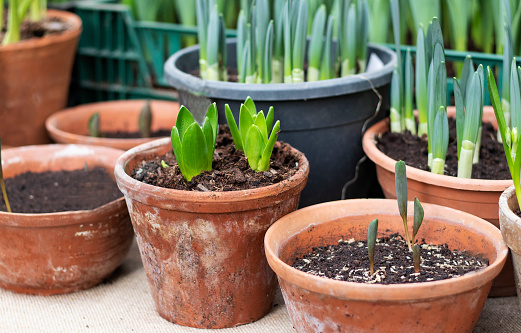Growing Spring Flowering Bulbs
The sight of the first snowdrops peeking through the soil always fills me with anticipation for a new gardening year. Along with early crocuses and Tete a Tete narcissi they bring a spring to my step as colour returns to the garden.

snowdrops
Spring flowering bulbs are usually available to buy from late August to December, but for the best choice buy them early and store them in a cool dark place until you are ready to plant.
Bulbs are some of the easiest garden plants to grow, needing only a well-drained soil and some sunshine, but it is best to avoid waterlogged soil and deep shade. Many are happy growing under deciduous trees and shrubs, where they can grow and flower before the leaves shade them.
Planting
Most spring flowering bulbs should be planted in September and October when their roots can start to grow in still warm soil. The exception is tulips which should be planted during November or even December.
Generally plant bulbs two to three times their own depth and around two bulb widths apart. Again the exception to this rule is tulip bulbs, which need to be planted at a depth of about 20cm. Planting at the correct depth will prevent your bulbs being damaged over winter by frost or pests.
It’s important to plant bulbs with its top facing upwards, it will normally be pointed. If unsure, plant the bulb on its side.
You may need to protect the bulbs from mice and squirrels, they particularly like crocuses, tulips, hyacinths, and iris, both the bulbs and young shoots.
Herbaceous borders
Bulbs planted in the herbaceous border will help to fill in gaps and provide colour and interest before perennials and shrubs begin to grow in early spring. Plant daffodils, winter aconites, tulips and fritillarias for outstanding colour. If like me, you can’t remember where the spaces are, plant the bulbs in pots so they can be planted out at flowering time when room can be found. Every year I mean to take a photo when the borders are in bloom so I can see where the bare patches are!
Formal planting
Plant bulbs in large groups for a formal bedding displays. Tulips look particularly impressive underplanted with spring flowers such as forget-me-nots.

tulips & forget me nots
Naturalising bulbs
Many spring-flowering bulbs are ideal for brightening up the base of trees before they come into full leaf. The soil beneath trees is moist and light, offering the perfect growing conditions for scillas, anemones, erythroniums and crocuses. My cyclamen and fritillarias are very happy under the dappled shade of a birch tree.

snake’s head fritillary
Bulbs such as dwarf daffodils, crocuses, snowdrops and winter aconites can transform a dull looking lawn into a wonderful display of colour. Daffodils particularly look amazing planted in drifts in large areas of grass. To achieve a natural look, throw bulbs up in the air and plant them where they land with a strong trowel or bulb planter. The aim is to make it look as though they have decided to grow there by themselves. To save time when planting small bulbs lift a piece of turf by slicing it off with a spade, then place the bulbs underneath and replace the turf.
Allow plants to die down after flowering before mowing over the lawn.
Bulbs in pots
If you want a great patio display, try growing bulbs in pots. Choose containers that will compliment your bulbs.
Bulbs don’t like being in waterlogged soil so use a bulb compost if available or fill pots with general-purpose compost, mixed with a handful of horticultural grit to improve drainage.
Keep it simple by densely planting a variety on its own, or several types can be planted together, but it can be tricky to get the flowers to appear at the same time. This can be worked to your advantage by selecting a range of bulbs and planting in a ‘lasagne’ for a longer flowering period.
In a deep container place the largest bulbs at the bottom, add a layer of compost and then the next sized bulbs. Repeat until you’ve placed the smallest bulbs at the top, covered with a layer of compost. Top off with grit to keep the leaves clean.

bulbs in pots
Water bulbs once after planting then regularly when in active growth.
If you’re growing bulbs in pots permanently, give them a liquid feed with a tomato type fertilizer after flowering to help feed next year’s bulbs, and store the pot somewhere cool over summer. Alternatively, after flowering replant them in the garden.
Apart from alpine varieties, tulips do not normally flower as well the second year, I plant them in the vegetable patch to provide cut flowers the following year.
Check pots in winter, ensuring they do not dry out completely. If you bring pots of hardy bulbs indoors during flowering, put them in a sheltered spot outside as soon as flowering is over.
Forcing Bulbs
For extra early pots of bulbs for Christmas try forcing them. Plant prepared bulbs of Hyacinths or Paperwhite Narcissus as soon as possible after purchase, place in a cool dark place for the roots to develop, watering occasionally when dry. Once the shoots have started to grow, after about 10 weeks, bring your bulbs indoors to a bright, cool spot such as a windowsill to come into flower. Keep the pots as cool as possible for the flowers to last longer.
A few Places to see flowering bulbs in Shropshire
Snowdrops – Attingham Park and Cound Brook
Daffodils – Gatten Valley Daffodil Field
Bluebells – Wenlock Edge and Old Oswestry Hill Fort
Formal Displays – The Dingle in The Quarry, Shrewsbury
Planting in the Green
Some bulbs such as Snowdrops and Bluebells and Winter
Aconites are best divided and planted ‘in the green’ when they are in full leaf just after flowering. This is because they do not like their bulbs to dry out. If you have trouble establishing snowdrops from dry bulbs try this method, they can usually be bought growing in pots in early spring.
Many varieties of bulbs can be bought growing in pots in early spring ready to plant out. We stock a great range of spring flowering bulbs, starting at £2.99, in pots and ready to enjoy right away!
Spring is here !


